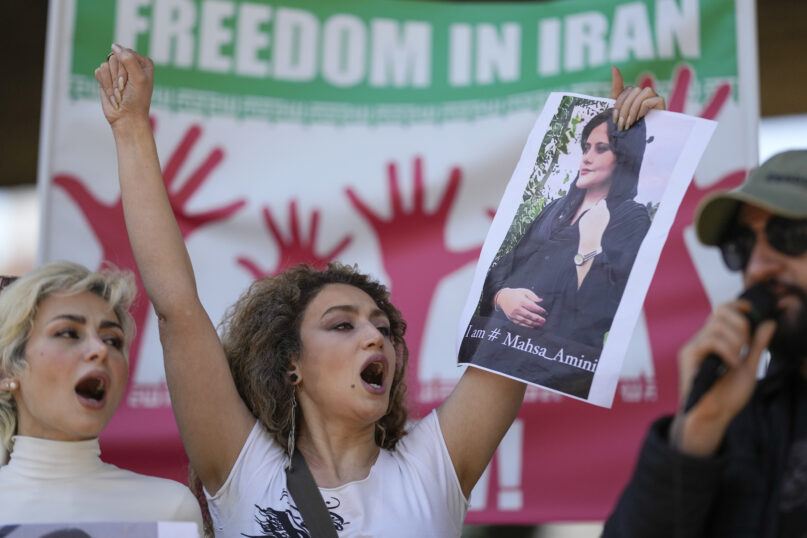

A newspaper with a cover picture of Mahsa Amini, a woman who died after being arrested by Iranian morality police, is seen in Tehran
Mon, October 10, 2022
DUBAI (Reuters) - Britain said on Monday it had sanctioned Iran's so-called morality police, saying the force had used threats of detention and violence to control what Iranian women wear and how they behave in public.
The death last month of 22-year-old Mahsa Amini in morality police custody sparked protests across Iran, with demonstrators calling for the downfall of Supreme Leader Ayatollah Ali Khamenei.
Citing her death and the subsequent protests, Britain said it had sanctioned the morality police in its entirety, as well as both its chief, Mohammed Rostami Cheshmeh Gachi, and the Head of the Tehran Division, Haj Ahmed Mirzaei.
Here are some facts about the force - known as the Gasht e Ershad or guidance patrols - which has also been sanctioned by the United States. The force is tasked with detaining people who violate Iran's conservative dress code. It aims to "promote virtue and prevent vice".
- The morality police, attached to Iranian law enforcement, are mandated to ensure the respect of Islamic morals as described by the Islamic Republic's top clerical authorities.
- The typical unit consists of a van with a mixed male and female crew that patrols or waits at busy public spaces to police behaviour and dress considered improper.
- People apprehended by the morality police are either given a notice or, in a few cases, taken to "correctional facilities" or a police station where they are lectured on how to dress or act morally before being released to their male relatives.
- Fines are sometimes given, although there is no general rule about pecuniary punishment.
- In Islam, hijab refers to what is deemed modest attire. Under Iran's sharia, or Islamic law, women are obliged to cover their hair and wear long, loose-fitting clothes to disguise their figures.
- Decades after the 1979 Islamic Revolution, clerical rulers still struggle to enforce the law, with many women of all ages and backgrounds wearing tight-fitting, thigh-length coats and brightly coloured scarves pushed back to expose plenty of hair.
- The morality police are often made up of and backed by the Basij, a paramilitary force initially mobilized to fight in the Iran-Iraq war in the 1980s.
- Basij have a presence in every Iranian university to monitor people's dress and behaviour, as higher learning is where Iranian male and females meet for the first time in a mixed educational environment.
HISTORY
- The fight against "bad hijab" is as old as the Islamic Revolution, which has erected the conservative dressing of women as one of its pillars.
- Over the revolution's early years, the state gradually imposed rules to enforce the wearing of Islamic attire by women.
- Buoyed by Ayatollah Ruhollah Khomeini's claims in favour of hijab after the Shah's 1979 fall, revolutionaries took it upon themselves to enforce their leader's positions by attacking unveiled women in the streets and shouting "Woman, wear a veil or eat my hand".
- Following several circulars shared by senior clerics and ministers, unveiled women were no longer allowed in public buildings and the non-wearing of the veil became punishable by 74 lashes after a 1983 law.
- Iran's new rulers struggled to control self-styled elements such as the Jundallah group, which patrolled streets to "combat bad hijab", and so they decided to institutionalise a morality police.
- Under reformist President Mohammad Khatami, state fervour to control dressing and behaviour in public spaces subsided, but at the end of his term in 2005, the Supreme Council of Cultural Revolution adopted a resolution entitled "strategies to develop a culture of chastity".
- Under Khatami's successor, the ultra-conservative Mahmoud Ahmadinejad, the morality police took their current Persian name of Guidance Patrols (Gasht e Ershad) and increased their presence in the streets of Iran's large cities.
- The need for a morality police was subsequently debated in the 2009 presidential elections, with reformist candidates calling for the dissolution of the force. However, no action has so far been taken to remove it, and many videos continue to be shared online of their sometime heavy-handed approach.
(Writing by Michael Georgy, Editing by William Maclean)

Newspapers with Amini, a victim of country's "morality police", are seen in Tehran
Mon, October 10, 2022
LONDON (Reuters) -Britain said on Monday it had sanctioned senior Iranian security officials and the country's "so-called Morality Police", saying the force had used threats of detention and violence to control what Iranian women wear and how they behave in public.
The death of 22-year-old Mahsa Amini in police custody has sparked protests across Iran and internationally, with demonstrators calling for the downfall of Supreme Leader Ayatollah Ali Khamenei.
Citing her death and the subsequent protests, Britain said it had sanctioned the morality police in its entirety, as well as both its chief, Mohammed Rostami Cheshmeh Gachi, and the Head of the Tehran Division, Haj Ahmed Mirzaei.
"These sanctions send a clear message to the Iranian authorities – we will hold you to account for your repression of women and girls and for the shocking violence you have inflicted on your own people," Foreign Secretary James Cleverly said in a statement.
Iranian authorities have described the protests as a plot by Iran's foes, including the United States.
The sanctions were made using British laws designed to encourage Iran to comply with international human rights law and respect human rights. They mean that those individuals named cannot travel to Britain and any of their assets held in Britain will be frozen.
Last week, the foreign ministry said it had summoned the Iranian charge d’affaires, Iran’s most senior diplomat in Britain, over the crackdown on the protests.
(Reporting by Muvija M and William James, editing by Sarah Young, William Maclean)













